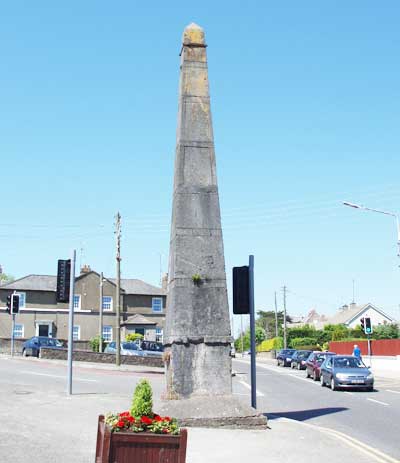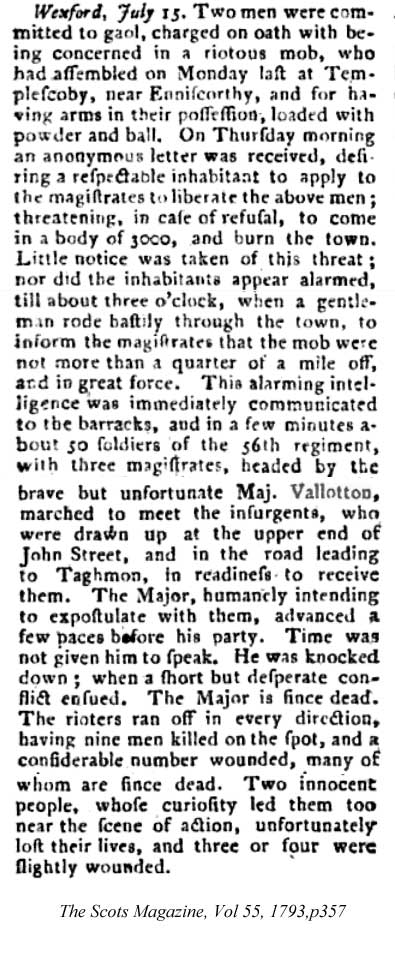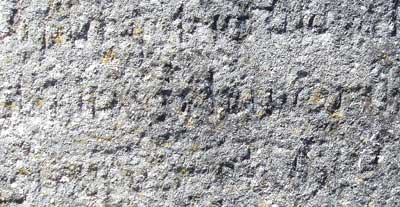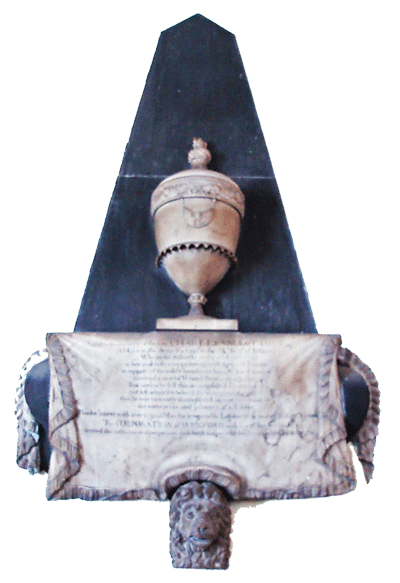Major Charles Vallotton

Let us set some context first. This is a hastily erected piece of crap. While it is referred to in some historical texts on Wexford town, it is virtually ignored as far as plaques and street documentation are concerned. There is nothing in its area to indicate what it is. You have to go to the history books, or to a parallel excercise inside St. Iberius church to find out what it is all about.
This visible neglect may arise from its having been erected to the memory of a British army officer who died defending Wexford against a crowd of anti-taxpaying rebels who were trying to free a colleague from Wexford jail. It looks a little reminiscent of the way Irish people who fought in WWI were treated until more recent times. I can imagine how difficult it would have been to put up a plaque in 1998 when the various 1798 committees were putting up plaques (or even two) at the various locations where the rebels vanquished their opponents or fell in the trying. However we are now nearly twenty years on and a little revisionism (not to mention some weedkiller) is clearly called for in this case.
Anyway the story is:
Groups resisting the payment of taxes were often raided by magistrates accompanied by troops. In 1793 some victims of such a raid in Bunclody ended up in Wexford jail. Some of their neighbours marched on Wexford to demand their release, gathering a crowd along the way.
Major Charles Vallotton was dispatched with some troops to stop them. The two forces met at Wygram. While the Major did succeed in dispersing the "rebels" he received wounds from which he subsequently died.
Wexford Corporation, in a desperate effort to assure the British authorities of their loyalty to the crown and their opposition to the rebels, hastily erected the obelisk monument to Vallotton They also put a monument on the wall of St. Iberius church in town.
There are different versions of how the violence started. It appears that Major Vallotton was parlaying with the rebels' spokesman, Moore, when he noticed a fellow officer being held by the rebels. He lost his cool, drew his sword and ran Moore through. Moore, however, caught him with a blow of his scythe and both men subsequently died from their injuries. Meanwhile the troops had opened fire on the crowd, and those of them who managed to escape the immediate fray were caught or killed by an unrelated troop returning to Wexford town.
Sir Richard Musgrave, has a cheekier version where he has major Vallotton "humanely expostulating with the rebels who gave him some desperate wounds of which he died soon after."
And the version below is from The Scots Magazine for 1793. Had you not known it was Wexford, you'd have thought they were talking about Enniscorthy, where some of the other prisoners from the magistrates raid were also being held.

The inscriptions
Of the two inscriptions, on the obelisk and in St. Iberius, only the latter remains legible, though it is likely that they were both more or less the same, with "in the suburbs" amended to "here" and so on.

The inscription on the obelisk (above), now illegible, was probably the same as, or similar to, the one on the wall of St. Iberius church. (see below)

The text of the inscription in Iberius church (above) is as follows:
Sacred to the memory of the late CHARLES VALLOTTON Esqr
A Major in the Army & a Capt in the 56th Regt of Infantry
Who in the Suburbs on the 11th of July 1793
when zealously co-opperating with the Civil Power
in support of the mild & beneficent laws of his Country
received a mortal Wound from a savage Hand.
Thus untimely fell this accomplish'd Gentleman
not less admir'd & belov'd for every social quality
than he was eminently distinguish'd on every occasion by
the enterprize and galantry of a Soldier
Reader lament with every good Man the irreperable Loss & strive to emulate his many Virtues
The CORPORATION of WEXFORD with becoming gratitude
erected this monument to perpetuate their high respect for his inestimable Character
Further background
A Major in the Army & a Capt in the 56th Regt of Infantry
Who in the Suburbs on the 11th of July 1793
when zealously co-opperating with the Civil Power
in support of the mild & beneficent laws of his Country
received a mortal Wound from a savage Hand.
Thus untimely fell this accomplish'd Gentleman
not less admir'd & belov'd for every social quality
than he was eminently distinguish'd on every occasion by
the enterprize and galantry of a Soldier
Reader lament with every good Man the irreperable Loss & strive to emulate his many Virtues
The CORPORATION of WEXFORD with becoming gratitude
erected this monument to perpetuate their high respect for his inestimable Character
Pages 23-25 of the descriptive text of the monuments in St. Iberius church.
Vallotton
Memorial no. 4 is "sacred to the memory of the late Charles Vallotton Esq. A major in the Army and a Captain in the 56th regiment of Infantry, who in the suburbs on the 11th of July 1793, when zealously co-operating with the civil powers in support of the mild and beneficent laws of his country received a mortal wound from a savage hand"
It goes on to praise in the floweriest language all his virtues. It was erected by the corporation of Wexford, whose minute book for 30th December 1793 reads as follows:
" ... It was unanimously agreed that a monument be erected in the church of the town, and a monumantal obelisk raised on the spot where he was killed at the expense of the corporation to the late Major Charles Vallotton of the 56th regiment of Infantry who fell in the defence of the town of Wexford, when attacked by a dangerous and riotous mob, and that the Burgesses now present or any five of them be a committee to determine on the plan, inscription and expense thereof."The Vallotton monument is still standing, and is situated at Wygram, at the top of Hill Street, opposite the entrance of the corporation offices.
Vallotton was commissioned into the 56th regiment of Foot on 16th June 1764, the regiment being then in Ireland. During the siege of Gibraltar in 1782 he became Aide de camp to general Elliot, who was governor of the Garrison at Gibraltar, with the rank of major. Gibraltar was under siege from an alliance of the French and Spanish who attacked from "floating batteries". These were make (sic) up of the hulk (sic) of a ship, large enough to mount fifteen 24 pounder cannons, and plated with green wood reinforced with old cables to resist penetration of ordinary shot, and with a syetem of pipes that would spray water on the outside for the extinguishing of red-hot shot. As it was required to do the minimum of sailing, the hulk (sic) could be heavily plated until it was as strong as a land battery, and the fire-extinguishing apparatus would obviate the danger that would threaten an ordinary man-of-war. Ten of these batteries were to be anchored within range of the Line Wall, in which, after eight or ten days, they would open a breach. Then 150 sloops carrying 50 men each would advance and land the troops who would make the assault.
This was the original plan, however, things went wrong and in the end the French and Spanish troops had to burn the floating batteries to prevent the enemy taking them as prizes. Vallotton was sent to carry the message of Victory back to England, and he was commended for his part in the siege. The national army museum in London has acquired a tea-caddy with a silver plaque inscribed:
Made of the Wood of the FLOATING BATTERIES Burnt at the siege of Gibraltar.
Major Charles Vallotton
1st Aide du Camp to
General Elliot
Major Charles Vallotton
1st Aide du Camp to
General Elliot
Major Vallotton was, in fact, killed by a John Moore, of Moore's cross, Palace-Robinstown, and he was also killed in the encounter and is buried at Carnagh, near Ballinaboola. There was a protest against the enforced paying of tithes to the Anglican church, to which most of the people did not belong, Moore went to parlay with Vallotton, and as they walked away, they turned on each other and were both mortally wounded. The Bishop, Dr. Caulfield, suggested that it was probably, high ranking Protestants who were behind this protest. The liberal Protestants, led by Hatton and Grogan at this stage were protesting against the formation of the Wexford militia, by the conservatives, Ely and Ogle, in response to the growing unrest. The issue of Tithes was an emotive one, and therefore useful to rouse the crowds, but the hidden agenda was the formation of the militia.